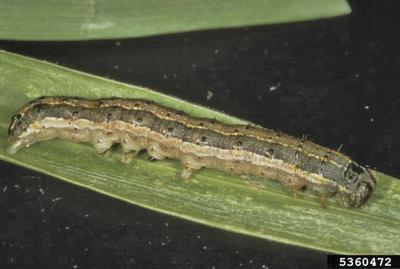Fall armyworms have recently become a serious pest throughout much of Northeast Iowa, says area field agronomist Joshua Michel with Iowa State University Extension.
Typically, fall armyworms fly in from the south on warm air currents. But weather conditions have converged to worsen the issue.
“Warmer and dryer than average weather, coupled with wind events a few weeks ago, may have helped contribute to the armyworm distribution,” Michel said.
“Unfortunately the armyworm lifecycles may likely continue until we have a frost event, and no they cannot overwinter in Iowa.
“Until such time, there may be multiple overlapping generations of armyworms that can feed on turfgrass and other plants. Thankfully, feeding damage isn’t usually severe enough to cause permanent turfgrass damage, and most grasses will grow back with proper maintenance and care.”
Persons who suspect an infestation in the yard or garden may read on for tips to confirm and manage it.
DAMAGE
“Fall armyworm caterpillars can feed on turfgrass,” Michel said. “The damage to turfgrass may vary in appearance and severity, according to grass type and maintenance practices. They will damage the grass by chewing on plant tissue.”
ACTIVITY
Armyworm caterpillars are most active in the early morning or late afternoon, but they may feed anytime of day.
“On tall, un-mowed grass, fall armyworms are obvious when feeding during the day. Whereas in regularly mowed grass, they may spend the warmer part of the day deep within the turf,” he said.
SCOUTING
“Home owners can look for armyworms in their yard by carefully scanning for areas that may appear droughty or brown in color. (This would indicate where severe feeding has occurred,)” Michel said in an email. “In tall grass, … a sweep net could be used.”
LOOK FOR PREDATORS
“The presence of birds or wasps may also be an indication that the turfgrass is infested with armyworms. Look for flocks of birds feeding consistently in turf areas or for holes pecked in the turf by birds.”
If birds or wasps are present, Michel recommends inspecting the turf for larvae or using a technique called a soap flush to bring larvae to the top of the turf.
SOAP FLUSH
To do a soap flush, mix 2 tablespoons of liquid dishwashing soap in 1 gallon of water. Using a watering can, pour the soapy water over a 1 to 2 square foot area. The armyworm larvae, if present, will emerge from the soil or thatch.
PROGNOSIS
The fall armyworm caterpillars tend not to overwinter this far north.
But they may persist in lawns until a frost event occurs, Michel indicated.
TREATMENT TIPS
Homeowners may treat for armyworms by either mowing or applying an insecticide. “If mowing is needed, do it before applying a chemical treatment. Mowing may mechanically destroy a few larvae, but it also reduces the depth of the turf the insecticide must penetrate,” Michel explained. “Granular insecticides may also be moved or removed by mowing equipment that catches clippings.
“Apply insecticides early or late in the day, because fall armyworm larvae are most active on turf at these times,” he said. Read the chemical label for the best information on application conditions and any post-treatment irrigation procedures.
LAWNS
Chemical lawn controls — although often not labeled for fall armyworms — are instead most likely labeled for caterpillar pests in turfgrass, Michel indicated.
“Most products available to homeowners are typically granular formulation of synthetic pyrethroids (such as bifenthrin),” he said.
Pyrethroids are manmade versions of pyrethrins, which come from chrysanthemum flowers, according to the National Pesticide Information Center.
“Granular formulations and the ready-to-use (RTU) spray formulations do not require mixing, dilution, or spray equipment, and can be purchased at any garden center or farm store,” Michel said.
GARDENS
“In regards to garden management and spraying on vegetables, I would suggest reading the chemical label for safety recommendations and considerations,” Michel said.














